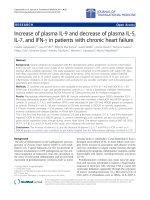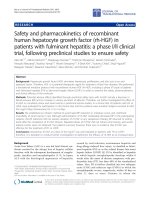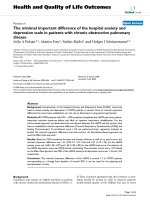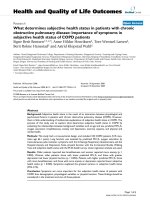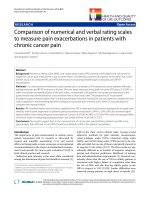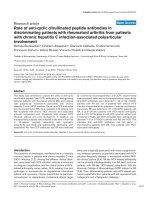Histopathological aspects described in patients with chronic hepatitis c
Bạn đang xem bản rút gọn của tài liệu. Xem và tải ngay bản đầy đủ của tài liệu tại đây (5.8 MB, 7 trang )
Rom J Morphol Embryol 2015, 56(2):439–444
RJME
ORIGINAL PAPER
Romanian Journal of
Morphology & Embryology
/>
Histopathological aspects described in patients with chronic
hepatitis C
FLORIN PETRESCU1), OCTAVIA ILEANA PETRESCU2), CITTO IULIAN TAISESCU3),
MARIA VICTORIA COMĂNESCU4), MIRCEA CĂTĂLIN FORŢOFOIU1), ION OCTAVIAN PREDESCU5),
ALEXANDRA FLORIANA ROŞU6), CRISTIAN GHEONEA2), VIOREL BICIUŞCĂ1)
1)
Department of Medical Semiology, Faculty of Medicine, University of Medicine and Pharmacy of Craiova, Romania
2)
Department of Pediatrics, Faculty of Medicine, University of Medicine and Pharmacy of Craiova, Romania
3)
Department of Physiology, Faculty of Medicine, University of Medicine and Pharmacy of Craiova, Romania
4)
Department of Pathology, Faculty of Medicine, “Carol Davila” University of Medicine and Pharmacy, Bucharest, Romania
5)
PhD student, Department of Histology, University of Medicine and Pharmacy of Craiova, Romania
6)
PhD student, Department of Gastroenterology, University of Medicine and Pharmacy of Craiova, Romania
Abstract
Chronic hepatitis C affects an estimated 170 million people worldwide and causes approximately 350 000 deaths each year. The current
antiviral therapy allows the virus eradication or the permanent inhibition of the virus replication (sustained virological response, SVR),
the reduction of the inflammation, and the prevention or the reduction of liver fibrogenesis (histological response). We studied the
histopathological aspects found during percutaneous liver biopsy in patients with chronic hepatitis C viral infection who were treated and
monitored over a period of two years. The assessment of the histological activity index through Ishak score determined the presence of:
mild chronic hepatitis in 12 (23.1%) patients, moderate chronic hepatitis in 21 (40.4%) patients, and severe chronic hepatitis in 19 (36.5%)
patients. The percutaneous liver biopsy performed on the patients with chronic viral hepatitis C showed a series of histological alterations,
the most frequent being: portal inflammation, periportal necrosis, lobular inflammation, focal necrosis, and hepatic fibrosis (scarring). The
severity degree of this histopathological aspect was correlated with the hepatitis activity index. The association of piecemeal with bridging
necrosis is the deadline at which the antiviral treatment can still be effective. Evidence of early fibrosis represent the important moment for
the antiviral treatment start. The specific histopathological aspects, but not pathognomonic, of chronic hepatitis C (hepatic steatosis, portal
lymphoid infiltrates and bile duct damage) had a reduced incidence, occurring in only half (hepatic steatosis), a quarter (portal lymphoid
infiltrates) and a fifth (destruction of biliary ducts) of all the patients with chronic viral hepatitis C, and these patterns was correlated with
advanced degree of necroinflammatory process of the liver, particularly in the portal tracts.
Keywords: chronic hepatitis, portal inflammation, lymphoid infiltrates, liver biopsy, hepatic steatosis.
Introduction
Chronic viral hepatitis C affects over 170 million
people worldwide and it is a major cause of morbidity
and mortality, these patients being exposed to a high
risk of developing hepatic cirrhosis, liver insufficiency
and hepatocellular carcinoma [1, 2].
The current antiviral treatment allows the cure of
over 75% of the patients with chronic hepatitis C virus
infection [3]. The main goal of the therapy is the virus
eradication or the permanent inhibition of the virus
replication (sustained virological response, SVR) from
all body compartments (serum, liver, and mononuclear
cells) [4]. Secondary goals are the reduction of the
inflammation and the prevention or the reduction of
liver fibrogenesis (histological response), accomplished
through aminotransferases normal values and improvement of the histological aspect [5]. Therefore, the histological response represents an important aspect to monitor
during antiviral treatment [6].
The aim of this study was to establish the opportunity
of the antiviral treatment in accordance with histopathological aspects described in patients with chronic hepatitis C.
ISSN (print) 1220–0522
Patients and Methods
We carried out a retrospective clinical trial in which
the histopathological aspects found during liver biopsy
on 52 patients with chronic hepatitis C were analyzed,
the patients were monitored and treated with antiviral
medication over a period of two years in the IInd Medical
Clinic, Emergency County Hospital of Craiova, Romania.
The chronic hepatitis C diagnosis was suggested by
the clinical examination, backed-up by the serum tests
(anti-HVC antibody screening), and confirmed by liver
biopsy and virological tests (quantitative HCV RNA
test). The selection criteria for including the patients in
the study group were the following: age range from 18
to 70 years; the presence of anti-HCV antibodies; detected
viral load HCV RNA; normal values of hematological
(platelet count >150 000/mm3) and biochemical parameters
(prothrombin index >70%). The criteria for leaving out
the patients from on the study group were: clinical and
paraclinical signs of cirrhosis (hemorrhagipar syndrome,
edema, bleeding esophageal varices, ascites); autoimmune
diseases (autoimmune hepatitis, autoimmune thyroiditis,
collagenosis); psychic disorders (chronic alcohol abuse,
ISSN (on-line) 2066–8279
Florin Petrescu et al.
440
high-risk drug addiction and hepatotoxic drugs) and
non-cooperative patients.
The liver biopsy was performed on the patients from
the study group through percutaneous method, using the
special kit Hepafix® (B. Braun Melsungen AG, Germany).
The liver tissue samples removed (with dimensions
between 10–25/1–1.4 mm) were placed in formaldehyde
and then analyzed according to the standard protocol
performed in the Laboratory of Pathological Anatomy,
Emergency County Hospital of Craiova.
Results
We studied the histopathological aspects found during
percutaneous liver biopsy in patients with chronic viral
hepatitis C infection who were treated and monitored
over a period of two years.
The patients group consisted of 12 men and 40 women,
with ages raging from 18 to 70 years, with body weights
varying from 55 to 120 kg.
The clinical manifestations described by patients were:
asthenia (40 patients; 76.9%), digestive manifestations
(24 patients; 46.1%), arthralgia and arthritis (15 patients;
28.8%), neuropsychiatric manifestations (13 patients; 25%),
hemorrhagic manifestations (eight patients; 15.3%) and
vascular purpura (seven patients; 13.4%). The main clinical
signs detected in these patients were: hepatomegaly (42
patients; 80.7%), splenomegaly (20 patients; 38.4%) and
jaundice (four patients; 8%).
The ultrasound examination showed values of anteroposterior diameter of the left lobe raging between 6.2
and 9.3 cm, with an average value of 7.35±0.74 cm. The
dimensions of the left lobe were over 6.7 cm (hepatomegaly) in 42 (80.7%) patients. The homogenous aspect
of the liver occurred in 32 (62.15%) patients, while the
inhomogeneous aspect found in 20 (37.85%) patients.
Liver steatosis with diffuse inhomogeneous aspect occurred
in 21 (40.38%) patients, while multifocal nodular steatosis
was recorded in only two (3.8%) patients. The longitudinal diameter of the spleen had values raging from 9
to 14.2 cm, with an average value of 11.7±1.74 cm. The
longitudinal diameter of the spleen over 12 cm (splenomegaly) was recorded in only 24 (46.1%) patients. The
diameter of hepatic portal vein, measured in the hepatic
hilum, had values raging from 0.7 to 1.4 cm, with an
average value of 1.1±0.19 cm. The value of the portal vein
diameter over 1.3 cm (ultrasound sign of portal hypertension) was larger in only four (7.6%) patients.
The hematological values recorded in these patients had
the following averages: hemoglobin 13.2±2.98 g% (9.1–
16.6 g%), leukocyte count 6535.5±2184.88/mm3 (3130–
9530/mm3), and platelet count 215 143.25±93 857.08/mm3
(90 000–366 000/mm3).
The biochemical parameters assessed for the patients
with chronic hepatitis had the following average values:
total bilirubin 1.16±0.4 mg% (0.8–2.2 mg%), alanine
aminotransferase (ALT) 107.8±67.5 U/L (21–258 U/L),
aspartate aminotransferase (AST) 96.64±47.82 U/L (24–
300 U/L), albumin 3.73±0.54 mg% (3.1–4.5 mg%), prothrombin index 92.9±7.4% (79–100%).
The average value of HCV RNA titer recorded for
the patients with chronic hepatitis was 1 040 477.05±
497 842.96 copies/mL, with limits from 807 to 3 510 000
copies/mL (Table 1).
The assessment of the histological activity index
(HAI) through Ishak score determined the presence of
mild chronic hepatitis (HAI 1–8) in 12 (23.1%) patients,
moderate chronic hepatitis (HAI 9–12) in 21 (40.4%)
patients, and severe chronic hepatitis (HAI 13–18) in 19
(36.5%) patients (Table 2).
Table 1 – Hematological, biochemical, and virological characteristics in patients with chronic hepatitis C
Hemoglobin [g%]
3
Leukocyte count [/mm ]
3
Platelet count [/mm ]
Total bilirubin [mg%]
ALT [U/L]
AST [U/L]
Albumin [mg%]
Prothrombin index [%]
ARN–VHC titer [copies/mL]
Mild chronic hepatitis
(12 pts; 23.1%)
13.26±2.1
7438.33±2091.21
270 525±95 475
1.1±0.3
77.62±35.3
65.6±32.4
3.9±0.5
94.5±6.4
827 376.08±342 589.67
Moderate chronic hepatitis
(21 pts; 40.4%)
12.93±3.67
6504.76±2195.24
199 904.76±118 096.24
1.2±0.5
121.04±88.96
114.66±45.54
3.8±0.54
93.8±6.3
1 026 476.19±535 489.81
Severe chronic hepatitis
(19 pts; 36.5%)
13.42±3.18
5668.42±2268.21
175 000±68 000
1.2±0.4
124.74±78.26
109.68±65.53
3.5±0.58
90.4±9.6
1 267 578.94±615 449.41
Table 2 – Ishak score which determined the severity of the necroinflammatory lesions and of liver fibrosis based on
the samples taken through liver biopsy punction
Periportal or
periseptal
interface hepatitis Score
(piecemeal
necrosis)
Absent
0
Necroinflammatory activity
Focal (spotty)
lytic necrosis,
Confluent
Portal
Score
apoptosis
Score
Score
necrosis
inflammation
and focal
inflammation
Absent
0
Absent
0
Absent
0
Mild (focal, few
portal areas)
1
Focal confluent
necrosis
1
One focus or less
per ×10 objective
1
Mild, some or
all portal areas
1
Mild (focal, few
portal areas)
2
Zone 3 necrosis
in some areas
2
Two to four foci
per ×10 objective
2
Moderate,
some or all
portal areas
2
Fibrosis
Description
Score
No fibrosis
Fibrous expansion of
some portal areas, with
or without short fibrous
septa
Fibrous expansion of
most portal areas, with
or without short fibrous
septa
0
1
2
Histopathological aspects described in patients with chronic hepatitis C
441
Necroinflammatory activity
Fibrosis
Periportal or
Focal (spotty)
periseptal
lytic necrosis,
Confluent
Portal
Score
Description
Score
interface hepatitis Score
Score
apoptosis
Score
necrosis
inflammation
(piecemeal
and focal
necrosis)
inflammation
Moderate
Fibrous expansion of
Moderate /
Zone 3 necrosis
Five to 10 foci per
(continuous around
most portal areas, with
3
3
3
marked, all
3
3
<50% of tracts or
in most areas
×10 objective
occasional portal to
portal areas
septa)
portal bridging
Fibrous expansion of
Zone 3 necrosis
Severe (continuous
most portal areas, with
+ occasional
More than 10 foci
Marked, all
around >50% of
4
4
4
4
marked bridging (portal
4
per ×10 objective
portal areas
portal-central
tracts or septa)
to portal as well as portal
(P-C) bridging
to central)
Zone 3 necrosis
Marked bridging with
+ multiple P-C
5
occasional nodules
5
bridging
(incomplete cirrhosis)
Panacinar or
Cirrhosis, probable or
6
6
multiacinar
definite
necrosis
The histopathological changes determined more
frequently in patients with mild chronic hepatitis were
portal inflammation in 14 (100%) patients, with an average
score 1, focal necrosis in 14 (100%) patients, with an
average score of 1.16±0.32, piece-meal necrosis in 14
(100%) patients, with an average score 1 and lobular
confluent necrosis in only five (41.6%) patients, with an
average score of 0.41±0.04. Other morphopathological
aspects determined seldom in these patients were lymphoid
infiltrates in three (25%) patients (Figure 1), microvesicular and macrovesicular steatosis in two (16.6%) patients
and lesions of the biliary ducts in one patient (8.33%).
Liver fibrosis occurred in 11 (91.66%) patients, with an
average score of 1.25±0.65. Stage 0 of fibrosis occurred
in one patient only (8.33%), stage 1 in seven (58.33%)
patients, and stage 2 in four (33.3%) patients.
The histopathological aspects determined in patients
with moderate chronic hepatitis were portal inflammation
in 21 (100%) patients (Figure 2), with an average score
of 1.72±1.28, focal necrosis in 21 (100%) patients, with
an average score of 1.8±1.2, piece-meal necrosis in 21
(100%) patients, with an average score of 2.57±0.43, and
lobular confluent necrosis in 12 (57.1%) patients, with
an average score of 0.85±0.61. The morphopathological
aspects described seldom in these patients were lymphoid
infiltrates in 12 (57%) patients, microvesicular and macro-
Figure 1 – Histological aspect of chronic viral hepatitis
C (CVHC) with mild activity. HE staining, ×100.
vesicular steatosis in eight (38.09%) patients and bile
ducts damages in four (19.04%) patients. Liver fibrosis
found in these patients was determined for all 21 (100%)
patients, with an average score of 1.76±0.24. Stage 2 of
fibrosis was present in 18 (85.71%) patients and stage 3
in three (14.29%) patients.
The histopathological alterations determined in patients
with severe chronic hepatitis were portal inflammation
in 19 (100%) patients (Figure 3), with an average score of
2.52±0.5, focal necrosis in 19 (100%) patients (Figure 4),
with an average score of 2.84±1.46, piece-meal necrosis
in 19 (100%) patients, with an average score of 3.1±0.75
and lobular confluent necrosis in only 15 (78.9%) patients,
with an average score of 1.42±0.87. Liver fibrosis described in the patients with severe chronic hepatitis was
determined in all 19 (100%) patients (Figure 5), with an
average score of 3.57±1.48. Stage 2 of fibrosis occurred
in one patient (5.2%) only, stage 3 occurred in nine
(47.36%) patients, stage 4 in seven (36.84%) patients,
stage 5 in one patient (5.2%), and stage 6 in one patient
(5.2%).
Other morphopathological aspects determined seldom
in these patients were lymphoid infiltrates in nine (47.36%)
patients, microvesicular and macrovesicular steatosis in
seven (36.84%) patients (Figure 6) and bile duct damage
in five (26.31%) patients.
Figure 2 – Histological aspect of CVHC with moderate
activity. HE staining, ×200.
442
Florin Petrescu et al.
Figure 3 – Histological aspect of CVHC with severe
activity. Portal inflammation with an inflammatory infiltrate consisting of lymphocytes, plasmocytes and polymorphonuclears inside the portal tracts. HE staining,
×200.
Figure 4 – Section of the liver biopsy specimen of patient
with CVHC. Focal necrosis with non-specific histopathological alterations, located at intralobular hepatocytes
level. HE staining, ×200.
Figure 5 – Microscopic image of CVHC associated with
porto-portal and porto-central fibrosis. GS trichromic
staining, ×200.
Figure 6 – Section of the liver biopsy specimen of patient
with CVHC. Hepatic steatosis, with many vesicles in the
cytoplasm of hepatocytes with net limits of various sizes.
HE staining, ×200.
Discussion
The most frequent histopathological aspects described
in patients with chronic viral hepatitis C were the portal
inflammation, periportal necrosis (piece-meal necrosis),
focal necrosis and liver fibrosis [8]. The histopathological
changes found seldom in these patients were confluent
necrosis (bridging necrosis), hepatic steatosis, lymphoid
infiltrates and lesions of the biliary ducts [9].
Portal inflammation, found in all patients (52 patients;
100%) with chronic viral hepatitis C, was the result of
the presence of an inflammatory infiltrate inside the
portal tracts consisting of lymphocytes, plasmocytes and
polymorphonuclears [10, 11]. The severity degree of
the inflammation was in direct relation to the chronic
hepatitis activity, thus the average severity degree of
inflammation was one in mild chronic hepatitis, 1.72 in
moderate chronic hepatitis, and 2.52 in severe chronic
hepatitis. The presence of portal inflammation in all
patients with chronic hepatitis C who had had biopsy
makes this histological marker useless as a marker for
antiviral therapy starting point [12].
Periportal necrosis, as a histological marker of necroinflammatory activity of chronic viral hepatitis C was
determined in all selected patients (52 patients; 100%),
and it defines the necrosis of periportal lobular hepatocytes, due to the intralobular spreading of inflammatory
infiltrate in the portal space. Periportal hepatocytes showed
a series of alterations, such as: ballooning degeneration,
acidophilic cytoplasm, apoptosis, as well as pseudoglandular pattern of hepatocytes (rosette formation). Piecemeal necrosis had different degrees of severity in accordance with the hepatitis activity index: average degree 1
in mild chronic hepatitis, average degree 2.57 in moderate
chronic hepatitis and average degree 3.1 in severe chronic
hepatitis. The spreading and distribution of periportal
necrosis were uneven, so that in mild and moderate forms
of hepatitis there were isolated focal spots of piecemeal
necrosis, while in severe forms the periportal necrosis
affected the entire area of portal spaces [13]. Furthermore,
in severe forms, apart from the necrosis alterations and
hepatocyte inflammation, the emergence of portal fibrosis
septa was observed, which marked out an aggravation of
Histopathological aspects described in patients with chronic hepatitis C
chronic viral hepatitis C and implicitly the necessity of
antiviral treatment initiation [14].
Focal necrosis of intralobular hepatocytes is characterized by non-specific histopathological alterations,
similar to those found in acute hepatitis, located at intralobular hepatocytes level [15]. It occurred in all selected
patients (52 patients; 100%) and it had different degrees
of severity in accordance with the hepatitis activity index:
average severity degree of 1.1 in mild chronic hepatitis,
average degree of 1.8 in moderate chronic hepatitis, and
average severity degree 2.8 in severe chronic hepatitis.
The spreading of focal necrosis varied in accordance
with the activity level of chronic hepatitis, thus in mild
hepatitis, the focal necrosis was limited, while in severe
hepatitis focal necrosis was associated with confluent
necrosis [16].
Confluent necrosis represents the extended necrosis
of intralobular hepatocytes, in the form of necrosis areas
that join the portal spaces between themselves (portoportal necrosis) or the portal spaces with the lobular vein
(porto-central necrosis) [17]. Confluent necrosis (bridging
necrosis) occurred in only 32 patients (61.5%; 32/52).
The severity degree of confluent necrosis had different
values in accordance with the hepatitis activity level; the
values determined being 0.40 in mild chronic hepatitis,
0.88 in moderate chronic hepatitis and 1.42 in severe
chronic hepatitis. We observed that the porto-portal necrosis
occurred mostly in moderate hepatitis, while porto-central
necrosis occurred in severe chronic hepatitis C. The
occurrence of bridging necrosis explained the disorder
rapid evolution, which was confirmed by the increased
serum values of aminotransferases [18]. Moreover, the
occurrence of confluent necrosis was correlate with the
occurrence of intralobular fibrous septa (fibrotic bridging),
implying the chronic hepatitis aggravation [19]. Therefore,
we can say that the occurrence moment of bridging necrosis
represent the appropriate moment for the antiviral treatment initiation, because the confluent necrosis fosters
the moderate and severe fibrosis evolution, resulting in
the occurrence of liver cirrhosis occurrence [20].
Hepatic fibrosis, recognized as the most important
factor in deciding the moment for the initiation of antiviral treatment, [21] was diagnosed in the majority of
patients with chronic viral active hepatitis C (98%; 51/52).
It occurred in stage 0 in one patient (1.9%), in stage 1 in
seven (13.7%) patients, stage 2 in 23 (45%) patients,
stage 3 in 12 (23.5%) patients, stage 4 in seven (13.7%)
patients, stage 5 in one patient (1.9%) and stage 6 in
one patient (1.9%). The severity degree of fibrosis was
correlated with the hepatitis activity index, the average
degree of fibrosis being 1.25 in patients with mild chronic
hepatitis; 1.76 in patients with moderate chronic hepatitis
and 3.57 in patients with severe chronic hepatitis. If the
stage 0 of fibrosis occurred in one patient (with mild
chronic hepatitis), portal fibrosis occurred in 30 patients,
portal and intralobular fibrosis in 19 patients, and liver
cirrhosis in two patients (with severe chronic hepatitis).
Therefore, evidence of early fibrosis (scarring) represent
the important moment for the antiviral treatment initiation
[22].
In addition to the diffuse portal inflammation, in 24
(46.1%) patients portal lymphoid infiltrates also occurred
443
(located changes of portal inflammation). The distribution
of this histopathological aspect was the following: 25%
(3/12 patients) of the patients with mild chronic hepatitis,
57% (12/21 patients) of the patients with moderate chronic
hepatitis, and 47.36% (9/19 patients) of the patients with
severe chronic hepatitis.
Hepatic steatosis is characterized by lipid accumulation
in hepatocytes, and is associated with portal and periportal activity more intense and advanced fibrosis [23,
24]. Vesicles in the cytoplasm of hepatocytes is affected
optically empty due to dissolution of lipids during inclusion
in paraffin, with net limits of various sizes. Hepatic
steatosis can be micro- and macrovesicular [25, 26]. In
micro-vesicular steatosis, we can notice small vesicles
located around the nucleus. Macrovesicular steatosis is
the most common, and appears through progressive
accumulation of lipids, so the nucleus is pushed to the
periphery. Sometimes, the two types of steatosis can
coexist [27]. Hepatic steatosis occurred in 17 (32.6%)
patients, the incidence of this alteration varying in
accordance with the hepatitis activity index: 16.6% of
the patients with mild chronic hepatitis, 38% of the
patients with moderate chronic hepatitis and 36.8% of
the patients with severe chronic hepatitis.
The destruction of the bile ducts was the histopathological aspect most rarely found in the patients with
chronic hepatitis C (19.2%; 10/52), the incidence of this
alteration depending on the hepatitis activity index: 8.3%
in patients with mild chronic hepatitis, 19.04% in patients
with moderate chronic hepatitis, and 26.31% in patients
with severe chronic hepatitis. In optic microscopy, bile
duct damage occurs as a parenchymal cholestasis, accompanied by hepatocyte resetting [28]. We can observe a
defect in epithelial wall, the presence of vacuolation and
stratification of epithelial cells, and the presence of
lymphocytic inflammatory infiltrate [29]. Sometimes was
described ductopenia. The occurrence of hepatitic bile
duct injuries was correlated with advanced degree of
necroinflammatory processes of the liver, particularly
in the portal tracts. Frequently, γ-GT (gamma-glutamyl
transpeptidase) was the parameter related to the presence
of bile duct lesions [30].
Conclusions
The percutaneous liver biopsy performed on the
patients with chronic viral hepatitis C showed a series of
histological alterations, the most frequent being: portal
inflammation, periportal necrosis, lobular inflammation,
focal necrosis, and hepatic fibrosis (scarring). The severity
degree of this histopathological aspect was correlated with
the hepatitis activity index. The association of piecemeal
with bridging necrosis is the deadline at which the antiviral treatment can still be effective. Evidence of early
fibrosis represent the important moment for the antiviral
treatment start. The specific histopathological aspects
(but not pathognomonic) of chronic hepatitis C (hepatic
steatosis, portal lymphoid infiltrates and bile duct damage)
had a reduced incidence, occurring in only half (hepatic
steatosis), a quarter (portal lymphoid infiltrates) and a
fifth (destruction of biliary ducts) of all the patients with
chronic viral hepatitis C, and these patterns were corre-
444
Florin Petrescu et al.
lated with advanced degree of necroinflammatory process
of the liver, particularly in the portal tracts.
Conflict of interests
The authors declare that they have no conflict of
interests.
[15]
Author contribution
All authors have contributed equally to the present
work.
[16]
References
[18]
[1] Perz JF, Armstrong GL, Farrington LA, Hutin YJ, Bell BP.
The contributions of hepatitis B virus and hepatitis C virus
infections to cirrhosis and primary liver cancer worldwide.
J Hepatol, 2006, 45(4):529–538.
[2] Veldt BJ, Heathcote EJ, Wedemeyer H, Reichen J, Hofmann WP,
Zeuzem S, Manns MP, Hansen BE, Schalm SW, Janssen HL.
Sustained virologic response and clinical outcomes in patients
with chronic hepatitis C and advanced fibrosis. Ann Intern
Med, 2007, 147(10):677–684.
[3] Shiffman ML. Hepatitis C virus therapy in the direct acting
antiviral era. Curr Opin Gastroenterol, 2014, 30(3):217–222.
[4] Jazwinski AB, Muir AJ. Direct-acting antiviral medications for
chronic hepatitis C virus infection. Gastroenterol Hepatol (N Y),
2011, 7(3):154–162.
[5] Marcellin P, Boyer N, Gervais A, Martinot M, Pouteau M,
Castelnau C, Kilani A, Areias J, Auperin A, Benhamou JP,
Degott C, Erlinger S. Long-term histologic improvement and
loss of detectable intrahepatic HCV RNA in patients with
chronic hepatitis C and sustained response to interferon-alpha
therapy. Ann Intern Med, 1997, 127(10):875–881.
[6] Lee YS, Yoon SK, Chung ES, Bae SH, Choi JY, Han JY,
Chung KW, Sun HS, Kim BS, Kim BK. The relationship of
histologic activity to serum ALT, HCV genotype and HCV RNA
titers in chronic hepatitis C. J Korean Med Sci, 2001, 16(5):
585–591.
[7] Ishak KG. Pathologic features of chronic hepatitis. A review
and update. Am J Clin Pathol, 2000, 113(1):40–55.
[8] Stănculeţ N, Grigoraş A, Predescu O, Floarea-Strat A, Luca C,
Manciuc C, Dorobăţ C, Căruntu ID. Operational scores in the
diagnosis of chronic hepatitis. A semiquantitative assessment.
Rom J Morphol Embryol, 2012, 53(1):81–87.
[9] Mosnier JF. Current anatomico-pathological classification of
hepatitis: characteristics of HCV infection. Nephrol Dial
Transplant, 1996, 11(Suppl 4):12–15.
[10] Wong VS, Wight DG, Palmer CR, Alexander GJ. Fibrosis and
other histological features in chronic hepatitis C virus infection:
a statistical model. J Clin Pathol, 1996, 49(6):465–469.
[11] Ionescu AG, Streba LA, Vere CC, Ciurea ME, Streba CT,
Ionescu M, Comănescu M, Irimia E, Rogoveanu O. Histopathological and immunohistochemical study of hepatic stellate
cells in patients with viral C chronic liver disease. Rom J
Morphol Embryol, 2013, 54(4):983–991.
[12] Khairy M, Abdel-Rahman M, El-Raziky M, El-Akel W, Zayed N,
Khatab H, Esmat G. Non-invasive prediction of hepatic fibrosis
in patients with chronic HCV based on the routine pre-treatment workup. Hepat Mon, 2012, 12(11):e6718.
[13] de Mello ES, Alves VAF. Chronic hepatitis C: pathological
anatomy. Braz J Infect Dis, 2007, 11(Suppl 1):28–32.
[14] Cheong HR, Woo HY, Heo J, Yoon KT, Kim DU, Kim GH,
Kang DH, Song GA, Cho M. Clinical efficacy and safety of
[17]
[19]
[20]
[21]
[22]
[23]
[24]
[25]
[26]
[27]
[28]
[29]
[30]
the combination therapy of peginterferon alpha and ribavirin
in cirrhotic patients with HCV infection. Korean J Hepatol,
2010, 16(1):38–48.
Karin M, Bevanda M, Babić E, Mimica M, Bevanda-Glibo D,
Volarić M, Bogut A, Pravdić D. Correlation between biochemical and histopathological parameters in patients with chronic
hepatitis C treated with pegylated interferon and ribavirin.
Psychiatr Danub, 2014, 26(Suppl 2):364–369.
MacSween RNM, Burt AD, Portmann BC, Ishak KG,
th
Scheuer PJ, Anthony PP. Pathology of the liver. 5 edition,
Churchill Livingstone, London, 2007, 409–441.
th
Scheuer PJ, Lefkowitch JH. Liver biopsy interpretation. 6
edition, W.B. Saunders, London, 2000, 36–50.
Marcellin P, Asselah T, Boyer N. Fibrosis and disease progression in hepatitis C. Hepatology, 2002, 36(5 Suppl 1):S47–
S56.
Fischer HP, Willsch E, Bierhoff E, Pfeifer U. Histopathologic
findings in chronic hepatitis C. J Hepatol, 1996, 24(2 Suppl):
35–42.
Arain SA, Jamal Q, Khan MA, Ahmed W. Pattern of histological findings in chronic hepatitis C with alanine transaminase
levels below twice the normal value. J Pak Med Assoc, 2011,
61(3):264–267.
Lagging LM, Westin J, Svensson E, Aires N, Dhillon AP,
Lindh M, Wejstål R, Norkrans G. Progression of fibrosis in
untreated patients with hepatitis C virus infection. Liver, 2002,
22(2):136–144.
Poynard T, Bedossa P, Opolon P. Natural history of liver
fibrosis progression in patients with chronic hepatitis C. The
OBSVIRC, METAVIR, CLINIVIR, and DOSVIRC groups.
Lancet, 1997, 349(9055):825–832.
Cornianu M, Dema A, Tăban S, Lazăr D, Lazăr E, Costi S.
Hepatic steatosis associated with hepatitis C virus infection.
Rom J Morphol Embryol, 2005, 46(4):283–289.
Irimia E, Mogoantă L, Predescu IO, Efrem IC, Stănescu C,
Streba LA, Georgescu AM. Liver steatosis associated with
chronic hepatitis C. Rom J Morphol Embryol, 2014, 55(2):
351–356.
Yoon EJ, Hu KQ. Hepatitis C virus (HCV) infection and hepatic
steatosis. Int J Med Sci, 2006, 3(2):53–56.
Moroşan E, Mihailovici MS, Giuşcă SE, Cojocaru E, Avădănei ER,
Căruntu ID, Teleman S. Hepatic steatosis background in
chronic hepatitis B and C – significance of similarities and
differences. Rom J Morphol Embryol, 2014, 55(3 Suppl):1041–
1047.
Negro F. Mechanisms and significance of liver steatosis in
hepatitis C virus infection. World J Gastroenterol, 2006,
12(42):6756–6765.
Kaji K, Nakanuma Y, Sasaki M, Unoura M, Kobayashi K,
Nonomura A, Tsuneyama K, Van de Water J, Gershwin ME.
Hepatitic bile duct injuries in chronic hepatitis C: histopathologic and immunohistochemical studies. Mod Pathol, 1994,
7(9):937–945.
Hwang SJ, Luo JC, Chu CW, Lai CR, Tsay SH, Chang FY,
Lee SD. Clinical, virological, and pathological significance
of hepatic bile duct injuries in Chinese patients with chronic
hepatitis C. J Gastroenterol, 2001, 36(6):392–398.
Giannini E, Botta F, Fasoli A, Romagnoli P, Mastracci L,
Ceppa P, Comino I, Pasini A, Risso D, Testa R. Increased
levels of gammaGT suggest the presence of bile duct lesions
in patients with chronic hepatitis C: absence of influence of
HCV genotype, HCV-RNA serum levels, and HGV infection
on this histological damage. Dig Dis Sci, 2001, 46(3):524–
529.
Corresponding author
Citto Iulian Taisescu, Lecturer, MD, PhD, Department of Functional Sciences, Faculty of Medicine, University of
Medicine and Pharmacy of Craiova, 2 Petru Rareş Street, 200349 Craiova, Romania; Phone +40722–520 531,
e-mail:
Received: November 5, 2014
Accepted: June 30, 2015
Copyright of Romanian Journal of Morphology & Embryology is the property of Romanian
Society of Morphology and its content may not be copied or emailed to multiple sites or
posted to a listserv without the copyright holder's express written permission. However, users
may print, download, or email articles for individual use.

